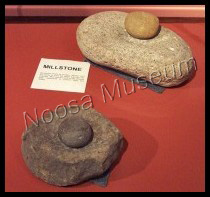Gubbi Gubbi Food Gathering & Hunting
The role of women in the task of supplying food was to gather and cook the smaller creatures and the plant - associated foods in the Gubbi Gubbi diet. In most groups the women were in fact the mainstays of their families in providing food.
Across the Gubbi Gubbi dyungungoo, women gathered shellfish, lobster, pipis and crabs along the coast; and freshwater mussels and yabbies in freshwater streams.
Fern roots and various seeds were prepared into a flour or paste and mixed with water to be roasted. With digging sticks hours were spent searching the ground for edible roots, yams, and insects as well as snakes and lizards.
Women were adept at climbing trees and helping men capture small-tree dwelling animals, birds and their eggs. On the coast and in the waterways women and men shared the work of gathering shellfish and fishing. The use of nets was common in Gubbi Gubbi country.
The basic work of men in the task of gathering food was as hunters and fishermen. When hunting, men used their knowledge of bush lore, their agility and their tracking skills, as they stalked their prey.
When fishing, they used their strength, their ability to stay underwater for long periods and their deftness to good effect. At times each man hunted alone, but mainly they hunted as a team.
Across the Gubbi Gubbi dyungungoo, women gathered shellfish, lobster, pipis and crabs along the coast; and freshwater mussels and yabbies in freshwater streams.
Fern roots and various seeds were prepared into a flour or paste and mixed with water to be roasted. With digging sticks hours were spent searching the ground for edible roots, yams, and insects as well as snakes and lizards.
Women were adept at climbing trees and helping men capture small-tree dwelling animals, birds and their eggs. On the coast and in the waterways women and men shared the work of gathering shellfish and fishing. The use of nets was common in Gubbi Gubbi country.
The basic work of men in the task of gathering food was as hunters and fishermen. When hunting, men used their knowledge of bush lore, their agility and their tracking skills, as they stalked their prey.
When fishing, they used their strength, their ability to stay underwater for long periods and their deftness to good effect. At times each man hunted alone, but mainly they hunted as a team.


